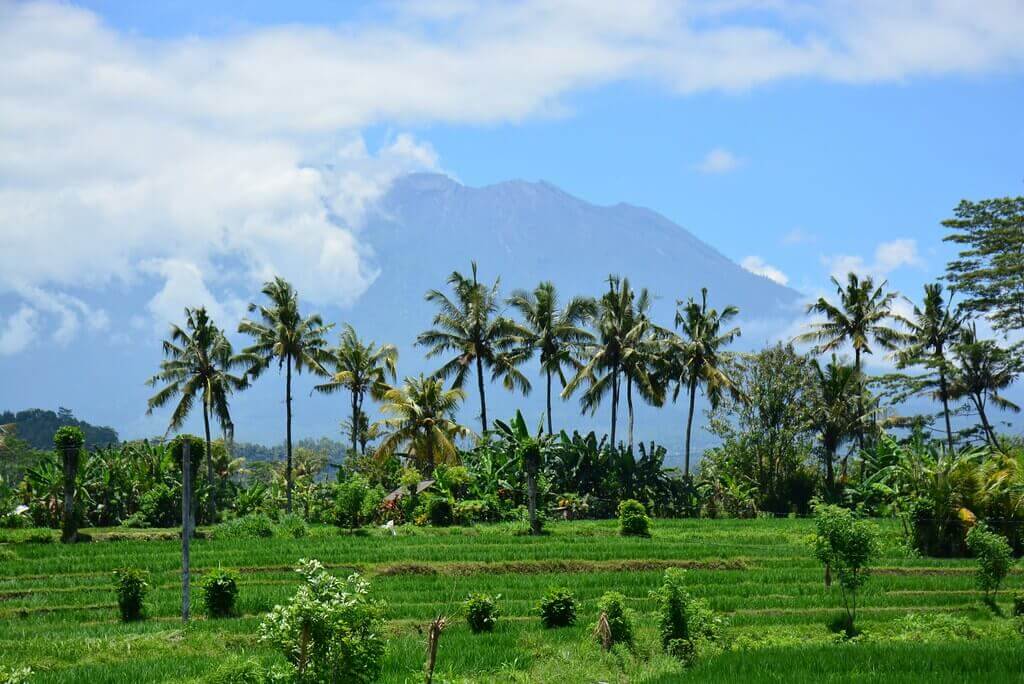Bali’s Climate: A Prelude to Paradise
Welcome to Bali, a picturesque island where the weather paints a backdrop as vibrant as its culture and landscapes. Nestled within the archipelago of Indonesia, Bali’s climate is a tropical treasure, a perfect blend of sunshine and rainfall, creating a lush environment that’s as diverse as it is beautiful. This introduction to this article about the weather in Bali serves as your guide to understanding and appreciating the unique temperature patterns that make Bali a year-round haven for travelers seeking both adventure and tranquility.
As we embark on this meteorological journey, we’ll uncover the nuances of Bali’s weather, from the sun-kissed days that beckon beach lovers to the balmy nights that call for intimate gatherings under the stars. Whether you’re planning to surf the legendary waves, explore the sacred temples, or simply unwind in the serene ambiance of Mookiland Family Park, Bali’s climate is ready to play its part in your unforgettable island experience.
So, let’s delve into the heart of Bali’s daily dance with the sun and the stars, where every hour holds the promise of new delights and the weather weaves its magic into every moment.
1. The Seasonal Faces of Bali – A Tale of Two Climates
Bali, a gem in the Indonesian archipelago, is famed for its verdant landscapes, cultural richness, and the warmth of its people. But it is the island’s dual-faced climate that adds a fascinating layer to its charm. Here, we embark on a journey through the dry and rainy seasons of Bali, each painting the island with a different palette of experiences.
Dry Season: Sun-Kissed Days and Starry Nights
The dry season, running from April to September, ushers in a period of sun-kissed days and balmy evenings. It’s the peak of Bali’s tourism, with the weather at its most benign, the humidity at a low ebb, and the winds carrying the salty whispers of the sea.
During these months, the days are long, filled with abundant sunshine that warms the sandy beaches and clear waters of the island’s famed coastlines. In the south, the upscale area of Seminyak buzzes with sunbathers, shoppers, and surfers riding the cerulean waves. Here, the weather is a perfect companion for those looking to indulge in Bali’s beachfront luxury and vibrant nightlife.
As you move inland, the climate remains your ally. Ubud, the cultural heartland nestled among emerald rice fields and ancient temples, benefits from cooler temperatures. The weather encourages exploration and discovery, from the Sacred Monkey Forest Sanctuary to the artisanal markets where the sun drapes over every colorful fabric and wood carving.
The dry season is also a time of celebration. The Bali Arts Festival in June and July turns Denpasar into a kaleidoscope of performance arts, traditional music, and dance, all thriving under the benevolent dry-season sun. It’s a period when the island’s soul is expressed most vividly, and the weather plays its part to perfection.
Rainy Season: A Revitalizing Touch to the Island’s Splendor
The rainy season, spanning from October to March, may deter some travelers as the island becomes more cloudy, but those who venture are rewarded with a Bali that is lush, less crowded, and more reflective. The weather brings life-giving water to the rice terraces, turning them into steps of vibrant green that cascade down the hillsides.
In average, this is not the relentless rain some might fear; it is instead a rhythm of short, intense showers that often come at night or in the late afternoon with cloudy dark sky, leaving the mornings and mid-days warm and clear for exploration. The rains are a time to witness Bali’s rivers in full flow, to see the waterfalls at their most majestic, and to experience the true fecundity of the tropics.
In beach towns like Amed and Lovina in the north, the rainy season casts a different spell. The weather here is often drier than in the south, allowing for uninterrupted dives into the undersea wonders with fewer boats and divers around. The black volcanic sands of these northern shores glint under the intermittent sun, offering a unique seaside excursion.
Embracing the Climate: A Guide for the Wise Traveler
Whether it’s the dry or rainy season, Bali’s weather demands respect and preparation. The savvy traveler will pack a versatile wardrobe – light, breathable clothing for the sunny days, and waterproof gear or rain coat for the unexpected shower, especially if you decide to drive a motorbike. The climate also calls for diligent sun protection during the dry months and mosquito repellent when the rains bring out the island’s insect life.
The changing seasons also impact the cost of travel. The dry season corresponds with peak tourism, driving prices higher for accommodations and activities. Conversely, the rainy season is considered the low season (except during Christmas and NYE’s period), offering more competitive rates and a quieter, more intimate encounter with the island’s many splendors.
Bali’s weather is not just a backdrop; it’s an active participant in the island’s daily life. It shapes the rhythms of the day, influences the ebb and flow of cultural events, and plays a critical role in the Balinese agricultural calendar. For those willing to embrace the island’s climatic duality, Bali unfolds its treasures generously, revealing a world where every season is a time to celebrate and every day is an invitation to adventure.
2. Bali’s Temperatures: A Day and Night Overview
The famed Island of the Gods, is graced with a climate that’s as warm and welcoming as its people. Here’s a glimpse into the typical temperature patterns you can expect during the daytime and nighttime across the island.
Daytime Delight: Warm Tropical Sunshine
As the sun rises over Bali’s verdant rice terraces and pristine beaches, the temperature begins its daily ascent. Daytime in Bali is synonymous with warmth, with the mercury often climbing to an average 30°C (86°F). This tropical heat is a constant companion for anyone enjoying the island’s countless outdoor activities, from surfing the waves of Kuta to exploring the ancient temples of Ubud. The sun’s embrace ensures a perfect setting for those looking to soak up the island’s vibrant energy and beauty.
However, this heat is not unrelenting. Thanks to Bali’s tropical setting, the heat is often tempered by a gentle ocean breeze, especially along the coast, providing a refreshing respite from the midday sun. In the highlands, like around Mount Batur or the serene Kintamani area, temperatures are noticeably cooler, offering a comfortable escape with spectacular views.
Nocturnal Nuances: Bali’s Soothing Evenings
As dusk falls and the hustle of the day transitions into tranquil evenings, Bali’s temperature takes a gentle dip. The night air cools to an average of around 22°C to 25°C (72°F to 77°F), perfect for al fresco dining under the stars or a moonlit walk along the beach.
In the more elevated regions, the night can bring a crispness to the air, inviting visitors to enjoy the comfort of a light sweater while dining outdoors or partaking in a nightcap. This cooler night temperature provides an ideal climate for restful sleep, rejuvenating travelers for the next day’s adventures.
3. Weather in Bali: Wind Patterns
In Bali, the wind isn’t just a current of air; it is the lifeblood of the island’s dynamic ecosystem, influencing everything from the climate to cultural festivities and adventure sports. The island’s geographical diversity creates a fascinating variety of wind conditions that are as contrasting as its landscapes, making wind patterns an essential aspect to consider for anyone visiting or engaging in outdoor activities.
The Seasonal Winds and Their Impact
Bali’s wind patterns are largely dictated by the monsoon seasons. The dry season, which typically runs from April to September, is characterized by the easterly trade winds. These are the months when the wind breathes life into water sports, with consistent windspeeds averaging around 15 mph (24 km/h), making it ideal for wind and kite surfing, especially on the eastern coasts of Sanur and Nusa Dua. The beaches here become playgrounds for enthusiasts looking to ride the crests and troughs of the Balinese waves, propelled by the steady, robust winds.
Conversely, the wet season brings with it the westerly winds that can be unpredictable, with windspeeds often fluctuating between a mild 3mph to 5 mph (5km/h to 8 km/h) to more boisterous gusts of up to 25 mph (40 km/h). The western part of Bali, including areas like Canggu and Tabanan, experience such high winds more prominently, which can affect sea conditions and beach experiences.
Topographical Influences on Wind Conditions
The island’s central highlands, with peaks like Mount Agung and Mount Batur, interact with these winds to create microclimates that can vary quite dramatically over short distances. In these highland areas, winds can accelerate through valleys and around mountains, often resulting in cooler temperatures and more vigorous wind activity that can exceed 20 mph (32 km/h), offering a refreshing respite from the coastal heat and an entirely different experience for hikers and nature enthusiasts.
Wind’s Role in Cultural Expression
Culturally, the wind plays a pivotal role in Bali’s iconic kite festivals, held primarily during the windy months of July and August. The Balinese skies are adorned with elaborate traditional kites, some with wingspans reaching over 10 meters, showcasing the craftsmanship and community spirit of the Balinese people. These festivals are not only a testament to the cultural importance of wind but also highlight the intricate understanding the Balinese have of their natural environment.
The Wind as Bali’s Breath
You need to understand that the winds of Bali are a force of nature that shapes the island’s weather, influences its culture, and fuels a variety of sports and leisure activities. Whether it is a gentle zephyr that cools a lazy afternoon or the mighty gusts that command the waves, the wind in Bali is a powerful element, measured and revered, integral to the fabric of daily life. For travelers and adventurers, understanding and respecting the wind’s patterns is essential for a fulfilling Balinese experience, as it truly is the breath of the island.

4. Bali Monthly Weather Guide
Bali’s tropical climate offers a diverse range of weather conditions throughout the year, each month presenting its unique charm and challenges. Here’s a snapshot of what to expect weather-wise during each month in Bali:
January: The heart of the rainy season, January sees frequent showers with high humidity. This is a great time for spa visits and cultural tours as the landscape turns a lush green.
February: Similar to January, with rain and warm temperatures, but with slightly fewer downpours. The weather can be unpredictable, so flexible plans are key.
March: The rain starts to subside, but occasional showers are still common. The island begins to dry out, and the weather becomes a mix of rain and sunshine.
April: Marking the transition to the dry season, April offers more sun, less rain, and the start of the surfing season on the west coast.
May: The weather is generally sunny and dry, ideal for outdoor activities and beach days. May is often considered one of the best times to visit Bali.
June: Dry and sunny, with low humidity and cool evenings, making it perfect for exploring the island’s natural landscapes and cultural sites.
July: Peak of the dry season with cool breezes, low rainfall, and a popular time for tourists, expect sunny days ideal for the beach and water sports.
August: Continues the trend of dry weather, with some of the year’s coolest temperatures. It’s also the windy season, great for kitesurfing and other wind-related activities.
September: Still within the dry season, the weather remains pleasant with less wind, and the tourist crowds begin to thin out.
October: The transition month back to the rainy season. Weather can be mixed, with both sunny days and increasing chances of rain as the month progresses.
November: The start of the wet season brings more rain, though typically in short, heavy bursts, with sunshine in between.
December: High rainfall with warm temperatures and high humidity. The end-of-year celebrations bring a festive atmosphere, despite the wetter conditions.
5. The Varied Climates of Bali’s Regions – A Weather Guide for Every Traveller
The island of Bali is a land of contrasts, not least when it comes to its climate. The weather can vary dramatically from coast to coast and from the lowlands to the highlands, creating microclimates that offer a unique experience in each region.
Ubud: Cultural Heart Amidst Humid Forests
In the cultural hub of Ubud, the climate is often more humid, and the sky more cloudy, but the lush forests and terraced rice fields provide a cooling green respite. Ubud’s higher elevation means temperatures are generally cooler here than in the coastal areas, and the weather can be quite pleasant, with occasional rain showers that turn the landscape into a vibrant green canvas. The rains nourish the Paddy fields, creating the iconic emerald-green landscapes that Ubud is renowned for.
Uluwatu and Nusa Dua: Ocean Breezes and Clear Skies
The southern limestone peninsula where Uluwatu and Nusa Dua are located is known for its clear skies and drier climate, even during the wet season. The weather here is heavily influenced by the ocean breezes, which keep the air fresh and the evenings cool. These areas are a paradise for water sports enthusiasts, with the weather playing into the hands of surfers who come to challenge the world-class waves.
Seminyak: Sunsets and Stylish Atmosphere
Seminyak, with its stylish beach clubs and boutiques, enjoys weather that supports its lively atmosphere. The sunsets here are legendary, and the weather rarely disappoints, providing spectacular skies that set the stage for evening festivities. The dry season is particularly vibrant in Seminyak, with fewer clouds to obstruct the view of the horizon.
Lovina and Amed: Tranquil Weather for the Serene Soul
The weather in the northern towns of Lovina and Amed is typically calmer and slightly cooler than in the south. Amed, with its dramatic black sand beaches and traditional salt farming, often enjoys a gentle breeze that makes the climate feel less intense. Lovina, known for its dolphin sightings, also benefits from the tranquil sea conditions, especially in the early morning when the weather is at its mildest.
Denpasar: A Bustling Capital in a Tropical Climate
Denpasar, Bali’s bustling capital, experiences a tropical climate that’s warm and humid year-round. The weather here can be unpredictable, with sudden showers that can quickly give way to sunshine. The city’s energy seems to sync with these weather patterns, always vibrant and ever-changing.
Planning Your Visit: The Best of Bali in Any Weather
Understanding the diverse weather patterns of Bali’s regions is key for travelers looking to plan their trip. Whether you’re seeking the sun-drenched beaches of the south, the cultural experiences of Ubud, or the diving adventures in Amed, the weather plays a pivotal role in what you can do and when.
For instance, if you’re planning to visit during the dry season, you’ll find that the beaches and outdoor attractions are at their best. This is the time for sunbathing, surfing, and enjoying the beach life to the fullest. Conversely, during the rainy season, you might want to focus on indoor cultural activities, such as visiting museums, temples, and art galleries, which offer shelter from the rain and an insight into Bali’s rich cultural heritage.
No matter the season or region, Bali’s weather is part of its allure, challenging and charming visitors in equal measure. In the next part, we’ll explore what activities you can enjoy in these different weather conditions, and how to make the most of your visit during any season.
6. Embracing Bali’s Weather – Activities and Travel Tips for All Seasons
Bali’s weather is as diverse as its landscape, presenting opportunities for unique experiences throughout the year. Whether you’re planning to surf the legendary waves during the dry season or seeking cultural enrichment in the rainy months, Bali has something special to offer.
Activities During Dry Season
The dry season, running from April to September, is characterized by low humidity, sparse rain, and plenty of sunshine. This is the perfect time for outdoor activities.
- Beach Exploration: Bali’s beaches come alive during the dry season. Visit the famous Kuta, Seminyak, and Nusa Dua beaches for sunbathing, swimming, and surfing.
- Diving and Snorkeling: Clear waters make this the ideal time for underwater adventures. Head to Amed or Menjangan Island for some of the best snorkeling and diving experiences.
- Hiking and Climbing: Bali’s mountains, including Mount Batur and Mount Agung, are more accessible during the dry season, offering spectacular sunrise views and a challenge for climbers.
Activities During Rainy Season
The rainy season spans from October to March, bringing heavy showers and high humidity, but also lush landscapes and a slower pace of life.
- Cultural Visits: Take advantage of the cooler, overcast days to explore Bali’s rich cultural heritage. Ubud is the cultural heart of Bali, offering art galleries, museums, and dance performances.
- Spa and Wellness: Bali’s wellness retreats are perfect for rainy days. Indulge in traditional Balinese massages, yoga classes, and meditation sessions.
- Culinary Adventures: The rainy season is an excellent time to dive into Bali’s culinary scene. Join cooking classes or go on food tours to savor local dishes.
Travel Tips for Bali’s Seasons
- Peak Season Considerations: The dry season is also peak tourist season. Plan and book in advance to secure accommodations and activities, and be prepared for higher prices.
- Rainy Season Travel: Travel can be tricky during the monsoon. Always check the weather forecast, plan for delays, and pack appropriate clothing. You can also use Forecast previsions before to start your day, such as Ventusky or Yr.
- Local Events: Check the Balinese calendar for festivals like Galungan, Kuningan, and Nyepi, which can offer unique experiences but also affect shop and business hours.
Cost Considerations
- Peak Season Premium: Expect to pay a premium for flights, hotels, and activities during the dry season from June to August, but also during Christmas / NYE’s period (ultra peak).
- Off-Peak Deals: You can find better deals during the rainy season, as hotels and tour operators often offer discounts.
A Year-Round Paradise
Bali is a true year-round destination, with each season offering its unique charm and activities. From the vibrant festivals and green landscapes of the rainy season to the sunny beaches and clear skies of the dry season, Bali ensures a memorable experience whenever you choose to visit.
In the next part, we’ll wrap up with some final thoughts on making the most of your trip here, no matter what the weather may bring.
7. Conclusion – Bali’s Climate and Embracing the Island’s Charm
As our exploration of Bali’s weather comes to a close, it’s clear that the island’s climate is as varied and inviting as its cultural tapestry. Each season paints Bali in a different light, offering travelers a spectrum of experiences and adventures.
The Allure of Bali’s Seasons
From the sun-drenched days of the dry season to the nourishing rains that bring life to its landscapes, Bali promises a wealth of experiences. It’s a place where you can ride the waves against a backdrop of a golden sunset or listen to the serene sound of rain while nestled in a cozy café in Ubud.
Savoring Every Moment
Bali’s climate encourages you to savor every moment. Whether you find yourself amidst the hustle of Denpasar, the tranquility of Sanur, or the breathtaking views of Badung, there is a rhythm to life here that’s governed by nature’s cycles. These moments are perfect for reflection, for finding joy in the simple things, and for creating memories that last a lifetime.
Travel Smart
Smart travelers know that Bali’s seasons are just a backdrop to the island’s endless offerings. With a bit of planning, you can navigate around peak prices in the dry season or enjoy the solitude and beauty that comes with the rainy season. Remember, the island’s climate is part of its charm, and embracing it fully can lead to the most authentic and rewarding experiences.
Leaving Footprints in Bali
As you plan your journey to this island paradise, consider the seasons, not as a constraint, but as a canvas. Whether you visit during the festive dry season or the introspective rainy season, Bali and its attractions like Mookiland are ready to welcome you with open arms. Here, every weather condition is a chance to witness a different shade of Bali’s vibrant character.
Final Thoughts on the weather in Bali
Bali is more than a destination; it’s an experience that changes with the weather, each day promising a new adventure. As you bid farewell to the island’s shores, you take with you not just souvenirs, but stories written in the language of the winds, the seas, and the Balinese sun, which, like the warm smiles of its people, shines bright all year round.




